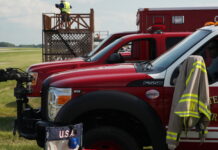Earlier this month, a Christian Eagle crashed while performing low-level aerobatics at a riverfront air show in Plock, Poland. The pilot, Szufa Marek, was killed in the accident, but – for North American air show professionals – the emergency response is worth our collective attention.
After a series of tumbling maneuvers left him too low to safely recover, this video shows that he impacts the water approximately 43 seconds into the video segment. If you let the video run, you’ll note that the first rescue boats don’t arrive at the accident scene until the 2:10 mark in the video, almost 90 seconds after the accident. And, when that first boat arrives, one man in the boat can be seen taking off his shirt/jacket, at about the 2:30 mark. He is not equipped with fins, mask or other underwater rescue equipment. The first would-be rescuer does not enter the water until 2:56, two minutes and 13 seconds after the crash. By the 3:15 mark, several other people had entered the water, but none of them appear to have the equipment needed to make an underwater rescue.
In contrast, look at this video of Adilson Kindleman’s accident during the Red Bull Air Race in Perth, Australia in April of 2010. In the video, he impacts the water at the 13 second mark. Within 14 seconds of the accident, two different jet skis operated by fully-equipped rescue specialists appear in the frame. Within another 15 seconds, a larger boat is seen approaching the crash scene. And by the time the video ends, 42 seconds after the crash, rescuers are poised to begin their rescue. We know from eyewitness accounts and other video that the rescuers were underwater, helping the downed pilot less than a minute after impact. Kindelman survived the accident with only minor injuries. Individuals familiar with details of the rescue believe that he would not likely have survived if he had spent even another 15-20 seconds underwater.
Although it may be tempting to criticize the Polish show organizer for their slow response, the truth is that very few air shows are prepared to respond as quickly and professionally as the Red Bull personnel did. The sad fact is that slow responses to emergencies in our business have had tragic consequences many times over the years…not just in other parts of the world, but here in North America. And not just small or unsophisticated shows, but even our largest and most well organized events. For most air shows, the emergency response is a document in a loose-leaf binder that they hope to never use. For Red Bull officials, the emergency water response plan was something that they had discussed in considerable detail with all of their pilots just days before Kindleman’s accident.
The take away? If you and your team are not prepared to execute a precise, thorough, frequently practiced emergency response, the most likely outcome will be that your emergency response personnel will respond slowly and arrive too late or arrive without the equipment needed to affect a successful response/rescue/extraction.








